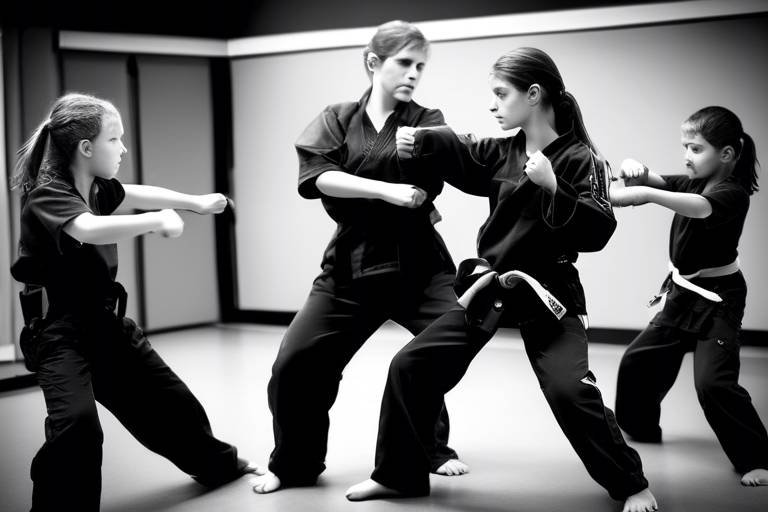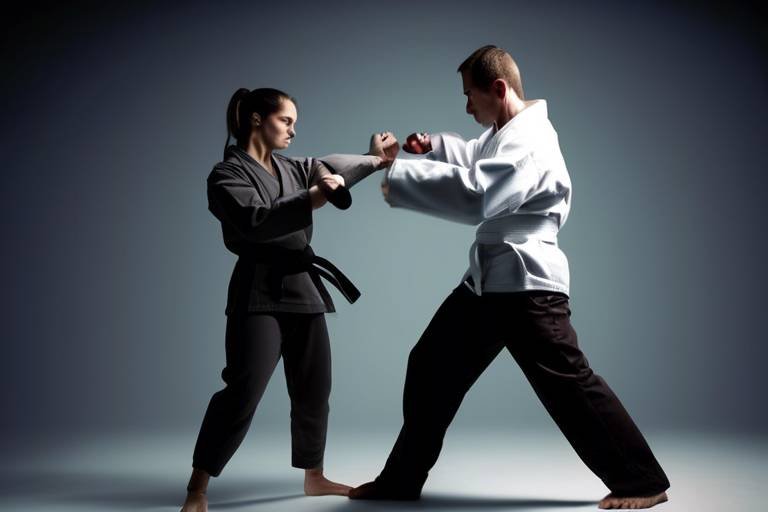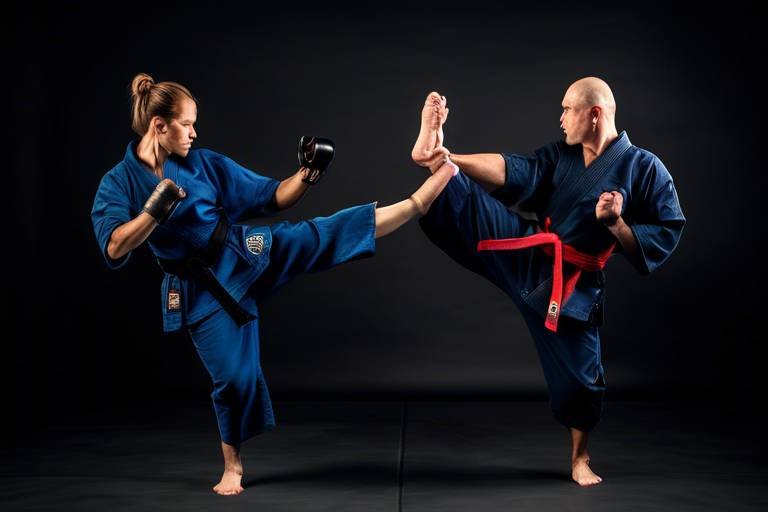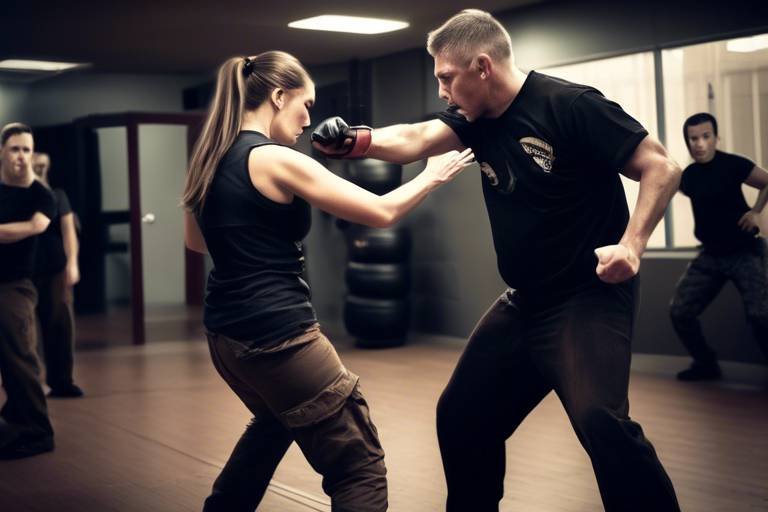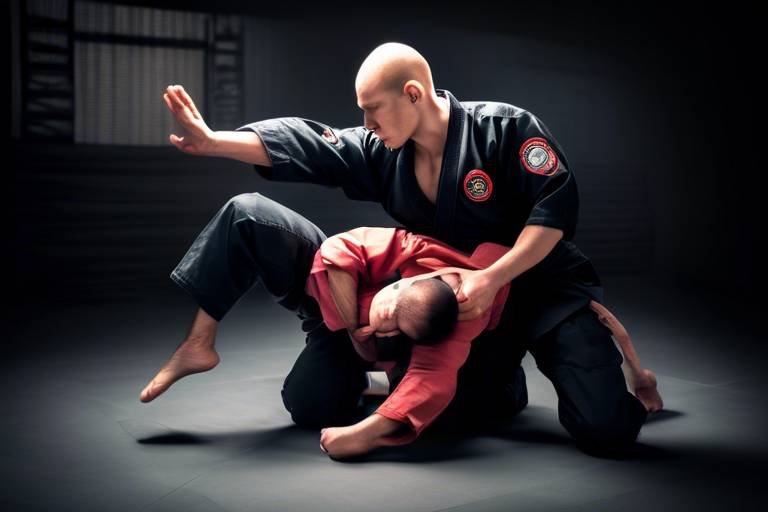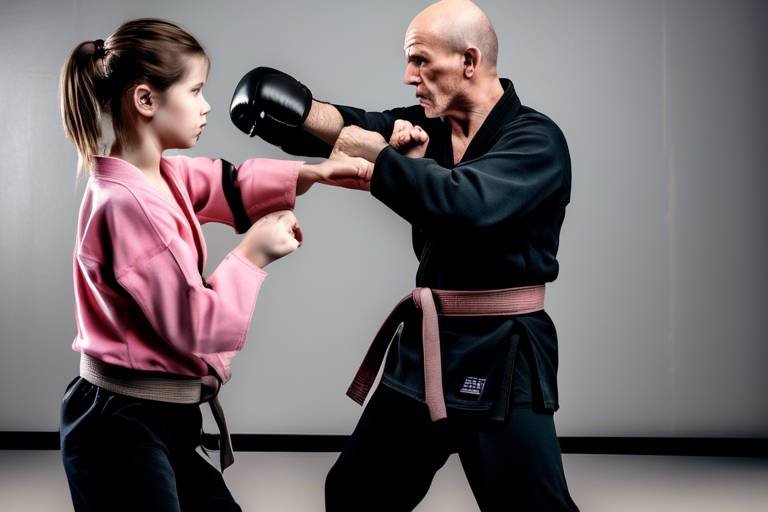Practicalities of Teaching Self-Defense Techniques in Schools
Teaching self-defense techniques in schools is not just about throwing punches or learning how to escape a hold; it’s about empowering students, building their confidence, and equipping them with essential life skills. In today’s world, where personal safety is a growing concern, the implementation of self-defense education in schools is becoming increasingly vital. Imagine a classroom where students not only learn math or science but also how to protect themselves in potentially dangerous situations. This holistic approach to education can transform the way young individuals perceive their own safety and well-being.
However, introducing self-defense into the school curriculum comes with its own set of challenges and considerations. First and foremost, schools need to ensure that the techniques taught are age-appropriate and suitable for the physical capabilities of the students. For instance, what works for a high school senior might not be appropriate for a fifth grader. Therefore, a well-structured curriculum that adapts to the needs of different age groups is essential.
Moreover, the psychological aspect of self-defense education cannot be overlooked. It’s not just about physical techniques; it’s also about mental preparedness. Students should learn how to assess situations, recognize potential threats, and respond appropriately. This mental training can be just as important as the physical skills they acquire. Schools should consider incorporating role-playing scenarios to help students practice their responses in a safe environment, allowing them to build confidence and reduce anxiety about real-life situations.
Another critical factor in teaching self-defense is the selection and training of qualified instructors. Schools must ensure that the instructors not only have expertise in self-defense techniques but also possess strong communication and teaching skills. They should be able to create a supportive learning environment where students feel safe and encouraged to participate. Additionally, instructors should be trained to handle sensitive situations, as discussions around self-defense can sometimes bring up personal experiences or fears among students.
Integrating self-defense into existing physical education programs can enhance the overall fitness of students while providing them with practical skills. By weaving self-defense techniques into activities that students already enjoy, such as martial arts or team sports, schools can make learning these skills more engaging and less intimidating. This integration can also promote teamwork and camaraderie among students, as they practice techniques together and support each other’s growth.
Addressing student concerns is paramount in creating a successful self-defense program. Many students may feel apprehensive about learning self-defense due to fears of injury or embarrassment. Schools should foster an open dialogue where students can express their concerns and feel heard. By creating a supportive environment, students are more likely to engage fully in the learning process and gain the confidence they need to apply what they’ve learned.
Parental involvement is another crucial element in the success of self-defense education in schools. Engaging parents in the conversation about self-defense can create a supportive community that extends beyond the classroom. Schools can host workshops or informational sessions for parents to discuss the importance of self-defense education and how they can reinforce these skills at home. This partnership not only enhances the effectiveness of the program but also promotes a culture of safety that permeates the entire community.
Legal and ethical considerations must also be taken into account when implementing self-defense education. Schools need to navigate potential liability issues and ensure that the training promotes responsible behavior and conflict resolution. It’s essential to teach students that self-defense is about protection, not aggression. By instilling a sense of responsibility in students, schools can help them understand the importance of using their skills wisely and ethically.
Finally, assessing the effectiveness of self-defense programs is vital for continuous improvement. Regular feedback from students and instructors can provide valuable insights into what is working and what needs adjustment. Schools should consider conducting surveys or focus groups to gather this feedback, ensuring that the program evolves to meet the changing needs of the student body.
- What age group is appropriate for self-defense training? Self-defense training can be adapted for various age groups, but it is essential to tailor the techniques and approaches to suit their physical and emotional development.
- Are self-defense classes safe for students? Yes, when conducted by qualified instructors in a supportive environment, self-defense classes prioritize safety and focus on injury prevention.
- How can parents support their children in self-defense education? Parents can engage in discussions about safety, attend workshops, and encourage their children to practice the skills they learn in school.
- What legal issues should schools consider? Schools must understand liability concerns and ensure that self-defense training promotes responsible behavior and conflict resolution.

Importance of Self-Defense Education
In today's world, where unpredictability seems to be the norm, understanding the importance of self-defense education in schools is more critical than ever. This isn't just about teaching kids how to throw a punch or escape a hold; it's about instilling a sense of empowerment and confidence in young individuals. Imagine walking down the street with your head held high, knowing you have the skills to protect yourself if the need arises. That’s the kind of mindset we want to cultivate!
Self-defense education plays a vital role in fostering a culture of awareness and preparedness. It equips students with the knowledge and skills to recognize potential threats and respond appropriately. This proactive approach not only enhances their physical safety but also contributes to their mental well-being. When students learn self-defense techniques, they develop a greater sense of control over their environment, which can significantly reduce anxiety and fear.
Moreover, self-defense education promotes important life skills beyond just physical techniques. It teaches students about boundaries, respect, and personal responsibility. They learn to assess situations critically and make informed decisions—skills that are invaluable both in and out of school. For instance, knowing when to engage and when to avoid confrontation is a crucial lesson that can prevent unnecessary escalation.
Additionally, self-defense training can serve as a powerful tool for community building. When students participate in group training sessions, they bond over shared experiences, fostering a sense of camaraderie and support. This collaborative environment encourages students to look out for one another, reinforcing the idea that safety is a collective responsibility.
In summary, the significance of self-defense education in schools cannot be overstated. It's about more than just physical techniques; it's about creating a generation of empowered individuals who are aware, confident, and capable of protecting themselves and their peers. As we move forward, it’s essential to integrate these teachings into our educational systems, ensuring that every student has the opportunity to learn and grow in a safe environment.

Curriculum Development
When it comes to for self-defense education in schools, the process is both an art and a science. Imagine crafting a program that not only imparts essential skills but also resonates with students on a personal level. The first step is to consider the diverse needs of the students. After all, a one-size-fits-all approach simply doesn't cut it in today's educational landscape.
Age-appropriateness is key. For younger students, techniques should focus on basic awareness and avoidance strategies, while older students can be introduced to more advanced techniques. This progression not only keeps students engaged but also builds their confidence as they master new skills. Additionally, physical abilities vary widely among students, so it's crucial to design a curriculum that accommodates different fitness levels and learning styles.
Moreover, the legal implications of teaching self-defense cannot be ignored. Schools must ensure that the techniques taught are safe and do not encourage aggressive behavior. This is where incorporating conflict resolution strategies becomes invaluable. By teaching students how to de-escalate situations verbally, we empower them to handle conflicts without resorting to physical confrontation.
To illustrate this point, consider the following table that outlines key components of an effective self-defense curriculum:
| Component | Description |
|---|---|
| Age-Appropriate Techniques | Tailored techniques based on students' age and maturity. |
| Physical Ability Consideration | Adaptations for varying fitness levels and physical capabilities. |
| Legal Awareness | Teaching students about the legal implications of self-defense. |
| Conflict Resolution | Strategies for de-escalating potential confrontations without physical force. |
In addition to these components, it's essential to continuously evaluate and update the curriculum based on feedback from both students and instructors. This iterative process helps ensure that the program remains relevant and effective. Regular assessments not only measure students' progress but also provide insights into areas that may require enhancement.
Furthermore, incorporating technology into the curriculum can offer exciting opportunities for engagement. For instance, utilizing video demonstrations or virtual reality simulations can create immersive learning experiences that captivate students' attention and enhance their understanding of self-defense techniques. Imagine students practicing their skills in a virtual environment, allowing them to learn without the fear of real-world consequences!
Ultimately, developing a self-defense curriculum is about more than just teaching techniques; it's about fostering a culture of awareness and preparedness. By equipping students with the knowledge and skills they need, we empower them to navigate the world confidently and safely. As we move forward, let’s embrace the challenge of creating a curriculum that not only educates but also inspires.
- What age should self-defense education start? Self-defense education can begin as early as elementary school, focusing on awareness and avoidance strategies.
- Are self-defense classes safe for students? Yes, when taught by qualified instructors, self-defense classes can be safe and beneficial for students.
- How can parents support self-defense education? Parents can engage in discussions about safety at home and encourage their children to practice skills learned in school.

Training Instructors
When it comes to teaching self-defense techniques in schools, the role of the instructor is absolutely pivotal. It’s not just about knowing how to throw a punch or execute a perfect escape maneuver; it’s about imparting confidence, building trust, and fostering a safe environment for students to learn. Selecting the right instructors is a multi-faceted process that requires careful consideration of various factors. First and foremost, instructors must possess a strong foundation in self-defense techniques. This means they should have a background in martial arts, personal safety, or a related field. But that’s just the beginning!
Instructors also need to have exceptional teaching skills. They must be able to break down complex techniques into digestible parts, ensuring that students of all ages and abilities can grasp the concepts. Think of it like teaching someone to ride a bike; you wouldn’t just shove them on and say, “Good luck!” Instead, you’d guide them step-by-step. Similarly, instructors should be patient and adaptable, ready to adjust their teaching methods to fit the needs of their students.
Additionally, having a solid understanding of the psychological aspects of self-defense is crucial. Self-defense isn’t just a physical skill; it’s about mental preparedness and awareness. Instructors must be equipped to teach students how to assess situations, recognize potential threats, and respond appropriately. This involves not only physical training but also discussions about situational awareness, conflict de-escalation, and the importance of avoiding confrontations whenever possible. It’s essential that instructors create a safe space for students to express their fears and concerns, which can significantly enhance the learning experience.
Moreover, schools should consider implementing a certification program for instructors. This not only ensures that they meet specific standards of proficiency but also provides a framework for ongoing education and development. Instructors should participate in regular workshops and training sessions to stay updated on the latest self-defense techniques and teaching methodologies. After all, the world is constantly changing, and so are the threats that individuals face.
To illustrate the importance of instructor training, let’s take a look at a simple table that outlines key qualifications and skills necessary for effective self-defense instructors:
| Qualification | Description |
|---|---|
| Martial Arts Background | Experience in martial arts or self-defense disciplines. |
| Teaching Skills | Ability to communicate effectively and adapt to student needs. |
| Psychological Understanding | Knowledge of mental preparedness and conflict resolution. |
| First Aid Certification | Basic first aid and CPR training to ensure student safety. |
| Continuous Education | Participation in workshops and training for skill enhancement. |
In conclusion, the effectiveness of self-defense training in schools largely hinges on the quality of instruction. By investing in qualified instructors who are well-rounded in both physical skills and psychological insights, schools can create a robust self-defense program that not only teaches students how to protect themselves but also empowers them to feel confident and capable in their everyday lives. After all, the goal is to equip students with the tools they need to navigate the world safely and responsibly.
- What qualifications should self-defense instructors have? Instructors should ideally have a background in martial arts, teaching experience, and knowledge of psychological aspects related to self-defense.
- How can schools ensure a safe learning environment? By selecting qualified instructors and fostering open communication, schools can create a supportive atmosphere for students to learn self-defense.
- What topics should be covered in self-defense training? Training should include physical techniques, situational awareness, conflict resolution, and psychological preparedness.
- How often should instructor training be updated? Regular workshops and training sessions should be held to keep instructors informed about the latest techniques and teaching methods.

Incorporating Self-Defense in Physical Education
Integrating self-defense techniques into physical education programs is not just a trend; it's a vital step towards equipping students with the skills they need to navigate an increasingly unpredictable world. Imagine a classroom where students not only learn about physical fitness but also gain the confidence to protect themselves. This dual focus on health and safety fosters a holistic approach to education, ensuring that students leave school not just academically prepared, but also ready to face real-world challenges.
Incorporating self-defense into the curriculum can significantly enhance students' overall fitness while providing them with practical skills for personal safety. By teaching self-defense techniques, schools can create an environment where students feel empowered. This empowerment is crucial, especially in a society where personal safety concerns are prevalent. When students practice self-defense, they learn to be more aware of their surroundings, which can lead to better decision-making in potentially dangerous situations.
Moreover, the physical benefits of self-defense training cannot be overlooked. Engaging in these activities promotes:
- Physical Fitness: Self-defense training is an excellent workout that improves strength, flexibility, and endurance.
- Coordination: Techniques often require precise movements, enhancing motor skills and coordination.
- Stress Relief: Physical activity is a great way to relieve stress, and self-defense can be particularly cathartic.
However, the successful integration of self-defense into physical education requires careful planning and execution. Schools must consider various factors, such as the age and physical abilities of students, to ensure that the techniques taught are appropriate and effective. Additionally, it's important to create a supportive environment where students feel safe to practice and make mistakes. This can be achieved through:
- Setting clear expectations and guidelines for behavior during training.
- Encouraging teamwork and collaboration among students to build trust.
- Providing a safe space for discussions about fears and concerns related to self-defense.
Furthermore, collaboration with experienced self-defense instructors can greatly enhance the quality of the program. These instructors can provide valuable insights into age-appropriate techniques and help develop a curriculum that aligns with educational standards. By leveraging their expertise, schools can ensure that students receive comprehensive training that not only teaches them how to defend themselves but also instills a sense of responsibility and respect for others.
In conclusion, incorporating self-defense into physical education is a multifaceted approach that benefits students in numerous ways. It not only enhances their physical fitness but also equips them with essential life skills. As schools continue to evolve, integrating self-defense education could become a cornerstone of student empowerment, fostering a generation that is not only fit but also self-aware and prepared for the challenges of life.

Addressing Student Concerns
When it comes to teaching self-defense in schools, is paramount. Many students might feel apprehensive about participating in self-defense classes, and it's essential to create an environment where they feel comfortable and supported. Common concerns include fears of injury, embarrassment, or even the perception that learning self-defense may be unnecessary. To tackle these issues, educators must foster open communication and provide reassurance.
First and foremost, it’s important to acknowledge that fear of injury is a valid concern. Students might worry about the physical aspects of self-defense training, especially if they are not accustomed to rigorous physical activity. To alleviate these fears, instructors should emphasize the importance of safety protocols and proper techniques. For example, incorporating warm-up sessions, using protective gear, and demonstrating techniques with partners can help mitigate the risks involved. This way, students can practice in a controlled environment where their safety is prioritized.
Additionally, the fear of embarrassment can be a significant barrier for many students. They might feel self-conscious about their physical abilities or worry about how their peers will perceive them. To combat this, instructors should create a supportive atmosphere where all students can learn at their own pace. Encouraging teamwork and emphasizing that everyone is there to learn can help break down these barriers. Instructors can also share personal stories or experiences to humanize the learning process, reminding students that everyone starts somewhere and that growth comes from practice.
Moreover, it's crucial to educate students on the importance of self-defense skills. Many might not realize that learning self-defense is not just about physical confrontation; it’s about building confidence and awareness. Engaging students in discussions about real-life scenarios can help them understand the relevance of these skills. For instance, sharing statistics about personal safety or discussing how self-defense can empower individuals can shift their perspective from viewing self-defense as an unnecessary activity to seeing it as an essential life skill.
Another effective strategy is to incorporate peer support systems within the training. Pairing students with buddies during practice sessions can foster camaraderie and reduce anxiety. This not only helps students feel more at ease but also encourages them to support each other throughout the learning process. Creating a culture of encouragement and mutual respect is vital; students should feel that they can express their concerns without judgment.
Finally, it’s essential to keep the lines of communication open. Regularly checking in with students about their feelings towards the self-defense program can provide valuable insights. Educators should encourage feedback and be willing to make adjustments based on student input. This not only shows that their opinions matter but also helps tailor the program to better meet their needs.
In conclusion, addressing student concerns about self-defense education is crucial for fostering a positive and effective learning environment. By prioritizing safety, promoting a supportive atmosphere, and emphasizing the importance of self-defense skills, educators can help students overcome their fears and embrace the opportunity to learn valuable techniques that can enhance their personal safety and confidence.
- What if I feel uncomfortable during self-defense training? It's important to communicate your feelings to your instructor. They can provide guidance and adjust the training to help you feel more comfortable.
- Do I need to be physically fit to participate in self-defense classes? No, self-defense classes are designed for all fitness levels. You can learn at your own pace, and the focus is on technique rather than physical strength.
- Will I really learn useful skills? Yes! Self-defense classes teach practical skills that can help you in real-life situations, as well as boost your confidence and awareness.

Parental Involvement
Engaging parents in the self-defense education process is not just a good idea—it's a game-changer. When parents are involved, it creates a supportive community that fosters discussions about safety and reinforces the skills their children learn in school. Think about it: when kids see their parents taking an interest in their self-defense training, it sends a powerful message that personal safety is a priority. This involvement can manifest in various ways, from attending workshops to participating in practice sessions. It’s like having a safety net that boosts confidence and encourages students to embrace the training.
Moreover, parental involvement can help alleviate some of the fears students may have about learning self-defense. For instance, if a child is apprehensive about getting hurt or feeling embarrassed during practice, knowing that their parents are supportive can make a world of difference. Parents can help foster an environment of open communication, where children feel comfortable expressing their concerns. This dialogue not only empowers students but also equips parents with the knowledge to discuss safety strategies at home, reinforcing what they learn in class.
To facilitate effective parental involvement, schools can organize informational sessions where parents can learn about the curriculum, the importance of self-defense, and how they can contribute. These sessions can include:
- Workshops: Hands-on sessions that allow parents to learn basic self-defense techniques.
- Q&A Panels: Opportunities for parents to ask questions and voice concerns about the program.
- Feedback Opportunities: Platforms for parents to provide input on the curriculum and their child's progress.
Additionally, schools can create resources such as newsletters or online platforms where parents can stay updated on what their children are learning. This not only keeps parents informed but also encourages them to engage in discussions about safety at home. By creating a partnership between schools and families, we can build a culture of awareness and preparedness that extends beyond the classroom.
In conclusion, parental involvement is essential in making self-defense education effective and impactful. When parents are actively engaged, it not only enhances the learning experience for students but also cultivates a community that prioritizes safety and empowerment. So, let’s rally parents to join the cause and transform self-defense education into a collaborative effort that benefits everyone involved!
Q1: Why is parental involvement important in self-defense education?
Parental involvement is crucial as it fosters a supportive environment for students, encourages open communication about safety, and reinforces the skills learned in school.
Q2: How can parents get involved in their child's self-defense education?
Parents can participate in workshops, attend informational sessions, and engage in discussions about safety at home to support their child's learning.
Q3: What are some concerns students might have about self-defense training?
Students may fear injury, embarrassment, or the intensity of the training. Addressing these concerns through communication and support can help ease their apprehensions.
Q4: How can schools facilitate parental involvement?
Schools can organize workshops, Q&A panels, and provide resources like newsletters to keep parents informed and engaged in their child's self-defense education.

Legal and Ethical Considerations
When it comes to teaching self-defense in schools, understanding the legal and ethical implications is absolutely essential. Schools must navigate a complex landscape of liability, consent, and the responsibilities that come with imparting self-defense techniques. After all, the goal is to empower students, not to put them—or the school—at risk.
One of the primary legal concerns involves liability issues. If a student is injured during a self-defense class, questions arise about who is responsible. Is it the instructor, the school, or the student themselves? To mitigate these risks, schools should consider implementing comprehensive waivers that parents and students sign prior to participation. These waivers can outline the potential risks associated with self-defense training and confirm that the school is not liable for injuries sustained during practice.
Additionally, it’s crucial to ensure that the self-defense techniques taught are not only effective but also legally permissible. Different states have varying laws regarding self-defense, including what constitutes reasonable force. Schools must ensure that instructors are well-versed in these laws to avoid teaching techniques that could lead to legal repercussions for the students or the school.
Ethically, schools have a responsibility to create a safe and supportive environment for all students. This includes addressing concerns about the potential for self-defense training to escalate into aggressive behavior. Instructors should emphasize that self-defense is about protection and de-escalation, not about fighting. This mindset should be ingrained in the curriculum, promoting the idea that physical confrontation should always be a last resort.
Another ethical consideration is the inclusivity of the self-defense program. It's vital to ensure that all students, regardless of gender, ability, or background, feel comfortable and empowered to participate. This can involve adapting techniques to suit different physical capabilities and ensuring that the training is sensitive to the diverse backgrounds of students. Schools should actively seek feedback from students to continuously improve the program and make it more inclusive.
To summarize, the legal and ethical considerations of teaching self-defense in schools can be boiled down to a few key points:
- Liability Risks: Implement waivers and ensure clear communication about risks.
- Legal Compliance: Stay informed about local laws regarding self-defense.
- Creating a Safe Environment: Focus on protection and de-escalation strategies.
- Inclusivity: Adapt techniques for diverse student needs.
By addressing these legal and ethical considerations thoughtfully, schools can create a self-defense program that not only teaches valuable skills but also fosters a culture of responsibility and respect. This approach not only protects the students but also enhances the overall educational experience, ensuring that self-defense training is a positive and empowering part of their school life.
Q: What are the legal risks of teaching self-defense in schools?
A: Legal risks include potential liability for injuries sustained during training. Schools can mitigate this risk by having students and parents sign waivers and ensuring instructors are well-informed about local laws regarding self-defense.
Q: How can self-defense training be made inclusive for all students?
A: To ensure inclusivity, instructors should adapt techniques to accommodate different physical abilities and backgrounds. Gathering feedback from students can help improve the program and make it more accessible.
Q: What should be emphasized in self-defense training?
A: The focus should be on protection and de-escalation, teaching students that physical confrontation should be a last resort. This helps cultivate a responsible mindset around self-defense.

Assessing Effectiveness
Regular assessment of self-defense programs in schools is not just a good idea; it's essential for ensuring that the training provided is both effective and relevant. Think about it: how can you improve something if you don't know how well it's working? By consistently evaluating the effectiveness of these programs, schools can identify strengths and weaknesses, adapt to the evolving needs of students, and ensure that the training is truly preparing them for real-world scenarios.
One of the most effective ways to assess these programs is through feedback mechanisms. This can include surveys, interviews, and focus groups with both students and instructors. By asking targeted questions, schools can gather valuable insights into what aspects of the program are working well and which areas might need a little more attention. For example, questions could cover:
- How confident do you feel in your ability to defend yourself after completing the program?
- What techniques did you find most useful?
- Were there any areas where you felt the training could be improved?
Additionally, schools can implement performance assessments to measure students' skills directly. This could involve practical demonstrations of self-defense techniques or scenario-based evaluations where students must respond to simulated threats. These assessments not only provide a clear picture of students' abilities but also help to reinforce learning by encouraging practice and application of skills in a controlled environment.
Another important aspect of assessing effectiveness is tracking long-term outcomes. Schools should consider how well students retain the skills they've learned over time. This could involve follow-up surveys or refresher courses to see if students still feel equipped to handle potentially dangerous situations months or even years after completing the program. By monitoring these outcomes, schools can adjust their training methods to ensure that the skills taught are not only learned but also retained.
Moreover, it's crucial to involve the entire school community in the assessment process. This means engaging not only students and instructors but also parents and local law enforcement. By creating a collaborative approach, schools can develop a more comprehensive understanding of the program's impact and effectiveness. For instance, parents can provide insights into their children's confidence levels at home, while law enforcement can share information about community safety trends that may influence training focus.
Ultimately, the goal of assessing effectiveness is to create a self-defense program that is not only informative but transformative. By continuously evaluating and improving the curriculum, schools can ensure that they are providing students with the tools they need to navigate the complexities of personal safety in today's world. With the right assessment strategies in place, self-defense education can evolve into a vital component of a well-rounded education, empowering students to face challenges with confidence and resilience.
- What is the main goal of self-defense education in schools?
The primary aim is to equip students with practical skills for personal safety and to foster confidence and awareness in potentially dangerous situations. - How can schools measure the success of their self-defense programs?
Schools can use feedback from students and instructors, performance assessments, and long-term outcome tracking to evaluate the effectiveness of their training. - Are there any legal considerations when teaching self-defense in schools?
Yes, schools must navigate liability issues and ensure that training promotes responsible behavior and conflict resolution. - How can parents get involved in self-defense education?
Parents can support their children by discussing safety at home, attending workshops, or participating in community events focused on self-defense.

Future Trends in Self-Defense Education
As we look ahead, the landscape of self-defense education is evolving in exciting ways. Technology is playing a pivotal role in this transformation, making training more accessible and engaging for students. Imagine a classroom where students can practice self-defense techniques through virtual reality simulations, allowing them to experience realistic scenarios without the physical risks. This not only enhances their learning experience but also builds their confidence in handling real-life situations.
Moreover, the integration of mental preparedness training is becoming increasingly important. Self-defense isn't just about physical techniques; it's also about cultivating a mindset that empowers individuals to assess situations critically and respond appropriately. Schools are beginning to incorporate modules that focus on situational awareness, de-escalation tactics, and emotional resilience. This holistic approach not only prepares students to defend themselves physically but also equips them with the mental tools to navigate potentially dangerous situations.
Another trend gaining traction is the emphasis on community involvement in self-defense education. Schools are partnering with local law enforcement and self-defense experts to host workshops and seminars. These collaborations foster a sense of community and provide students with diverse perspectives on safety and self-defense. Additionally, engaging parents and guardians in these discussions can create a supportive network that reinforces the skills learned in school.
In terms of curriculum development, there is a growing awareness of the need for inclusive self-defense training. Programs are being designed to accommodate students of all abilities and backgrounds. This means recognizing the unique challenges faced by different groups and tailoring instruction to meet their needs. For instance, self-defense techniques for individuals with disabilities are being developed, ensuring that everyone has the opportunity to learn how to protect themselves.
Lastly, the conversation around legal and ethical considerations in self-defense education is becoming more pronounced. Schools are increasingly aware of their responsibilities in teaching self-defense. They must ensure that the training promotes responsible behavior and conflict resolution rather than aggression. This shift in perspective encourages students to view self-defense as a last resort, emphasizing the importance of communication and understanding in resolving conflicts.
In conclusion, the future of self-defense education in schools is bright and filled with possibilities. By embracing technology, focusing on mental preparedness, fostering community involvement, ensuring inclusivity, and navigating legal and ethical considerations, educational institutions can create a robust self-defense program that empowers students and enhances their safety. Are you ready to embrace these changes and equip the next generation with the skills they need to defend themselves?
- What are the benefits of self-defense education in schools? Self-defense education promotes safety, builds confidence, and empowers students to handle potentially dangerous situations effectively.
- How can technology enhance self-defense training? Technology, such as virtual reality, can provide realistic training scenarios, making learning more engaging and practical.
- What should be included in a self-defense curriculum? A comprehensive curriculum should include physical techniques, mental preparedness training, and conflict resolution strategies.
- How can parents get involved in self-defense education? Parents can participate in workshops, discussions, and support their children’s learning by reinforcing skills at home.
- Are self-defense programs inclusive? Yes, many programs are being designed to cater to students of all abilities and backgrounds, ensuring everyone can learn self-defense techniques.
Frequently Asked Questions
- Why is self-defense education important in schools?
Self-defense education is vital for student safety and empowerment. It equips young individuals with the skills to protect themselves in potentially dangerous situations. Moreover, it fosters a culture of awareness and preparedness, helping students build confidence and resilience.
- What should be included in a self-defense curriculum?
A self-defense curriculum should encompass age-appropriate techniques that consider students' physical abilities and legal implications. It should cover practical skills, situational awareness, and conflict resolution strategies, ensuring that students receive comprehensive training relevant to their needs.
- How can schools select qualified self-defense instructors?
Schools should look for instructors with expertise in self-defense, teaching experience, and an understanding of the psychological aspects of self-defense training. Conducting background checks and requiring certifications can help ensure that instructors are qualified to teach these important skills.
- Can self-defense techniques be integrated into physical education programs?
Absolutely! Incorporating self-defense techniques into existing physical education programs not only enhances students' overall fitness but also provides them with practical skills for personal safety. This integration makes self-defense training a valuable addition to the curriculum.
- What if students are afraid of getting injured during self-defense training?
It's essential to address students' concerns about injury openly. Creating a supportive environment where students can express their fears and receive reassurance can help alleviate anxiety. Instructors should emphasize safety protocols and encourage gradual skill development to build confidence.
- How can parents get involved in self-defense education?
Engaging parents in the self-defense education process is crucial. Schools can host workshops or informational sessions to inform parents about the curriculum. This involvement fosters a supportive community and encourages discussions about safety at home, reinforcing the skills students learn in school.
- What legal considerations should schools keep in mind when teaching self-defense?
Schools must navigate various legal and ethical implications when implementing self-defense programs. This includes understanding liability issues, ensuring that training promotes responsible behavior, and emphasizing conflict resolution to prevent escalation in real-life situations.
- How can the effectiveness of self-defense programs be assessed?
Regular assessment of self-defense programs is essential to evaluate their effectiveness. Schools should gather feedback from both students and instructors to identify areas for improvement. This ongoing evaluation helps adapt the training to meet the evolving needs of the school community.
- What are some future trends in self-defense education?
Emerging trends in self-defense education include the integration of technology, such as virtual reality training, and a focus on mental preparedness. These innovations can help schools stay relevant and responsive to the changing landscape of personal safety, ensuring students are well-equipped for modern challenges.

